Issues of Water Resources in Saudi Arabia: Past, Present, and Future
Abstract
1. Introduction
2. Materials and Methods
3. Results and Discussion
3.1. Water Demand in Saudi Arabia
3.2. Water Supply in Saudi Arabia
3.3. The Gap between Water Demand and Supply
3.4. Water Consumption Assessment Based on Five-Years Development Plan
3.5. Regional Growth of Water Consumption
3.6. Projections of Future Water Demand by Sector
- The highest growth in water consumption has to be in the industrial sector in the next 15 years.
- The industrial sector needs particular attention regarding water management to meet the expected high demand for water consumption in the upcoming decades.
- The municipal sector will have slow growth as compared to the industrial demand for water consumption.
- The agricultural sector is showing an entirely different trend that will decline sharply and help to maintain a balance between total water supply and demand, holding as it does the largest share among all sectors.
- It is anticipated that the total water demand, including all sectors, will decline and open opportunities to ensure sustainability for the Kingdom during 2015–2029.
- The demand–supply curve will remain positive in upcoming decades for the Kingdom’s water resources.
4. Conclusions
5. Recommendations
- Several studies [78,79,80,81] conducted on the feasibility of fog water collection in some arid areas have shown good potential in the development of non-conventional water resources. The coastal region of Saudi Arabia has good potential in this regard, as fog formation is a widespread phenomenon in many parts of the tropical, temperate, and arid regions of the world.
- The shift of the agricultural sector to a water surplus region, or bilateral ties with foreign nations, could ensure water saving. However, this could increase the level of dependency on the host nation.
- Water could be saved through the cultivation of less water-consuming crops, rather than investing in high water-consuming crops, like wheat and rice. The proper balance between the import and export of food commodities can minimize the gap in water resources.
- Weather modification, leakage prevention during water distribution, efficiency improvement, and several other small measures could contribute to water saving in Saudi Arabia.
Author Contributions
Funding
Institutional Review Board Statement
Informed Consent Statement
Data Availability Statement
Acknowledgments
Conflicts of Interest
References
- Thornethwaite, C.W. An Approach towards a Rational Classification of Climate. Geogr. Rev. 1948, 38, 55–94. [Google Scholar] [CrossRef]
- WWAP. Water in a Changing World: World Water Development Report 3; UNESCO/Earthscan: Paris, France, 2009. [Google Scholar]
- Almazroui, M. Calibration of TRMM rainfall climatology over Saudi Arabia during 1998–2009; Atmospheric Research Online; Elsevier: Amsterdam, The Netherlands, 2010; pp. 1–15. [Google Scholar]
- Almazroui, M.; Abid, M.A.; Athar, H.; Islam, M.N.; Ehsan, M.A. Interannual variability of rainfall over the Arabian Peninsula using the IPCC AR4 Global Climate Models. Int. J. Climatol. 2012, 33, 2328–2340. [Google Scholar] [CrossRef]
- WWF. Water Scarcity: Threat. 24 August 2013. Retrieved from World Wild Life. Available online: http://worldwildlife.org/threat/water-scarcity.htm (accessed on 12 October 2013).
- Abderrahman, W.A. Groundwater Resources Management in Saudi Arabia, Special Presentation at Water Conservation Workshop; Khobar, Saudi Arabia, 2006; Available online: http://sawea.org/pdf/FutureOfSaudiArabianWaterAquifers.pdf (accessed on 7 October 2023).
- Falkenmark, M. Meeting Water Requirement of an Expanding World Population. Philos. Trans. R. Soc. Lond. 1997, 352, 929–936. [Google Scholar] [CrossRef]
- Cruz, R.V.; Harasawa, H.; Lal, M.; Wu, S.; Anokhin, Y.; Punsalmaa, B.; Honda, Y.; Jafari, M.; Li, C.; Ninh, N.H. Asia: Climate Change—2007: Impacts, Adaptation, and Vulnerability. Contribution of Working Group II to the Fourth Assessment Report of the Intergovernmental Penal on Climate Change; Parry, M.L., Canziani, O.F., van der Linden, J.P., Hanson, C.E., Eds.; Cambridge University Press: Cambridge, UK, 2007; pp. 469–506. [Google Scholar]
- Petterssen, S. Introduction to Meteorology; McGraw Hill Book Co. Inc.: New York, NY, USA, 1941. [Google Scholar]
- Meige, P. World Distribution of Arid and Semi-Arid Homoclimates. In UNESCO, Reviews of Research on Arid Zone Hydrology; UNESCO Press: Paris, France, 1953; pp. 203–210. [Google Scholar]
- Edgell, H.S. Arabian Deserts: Nature, Origin and Evolution; Springer: Amsterdam, The Netherlands, 2006. [Google Scholar]
- Ahrens, C.D. Meteorology Today: An Introduction to Weather, Climate, and the Environment, 9th ed.; Cengage Learning: Boston, MA, USA, 2008. [Google Scholar]
- Vincent, P. Saudi Arabia: An Environmental Overview; Taylor & Francis Group: London, UK, 2008. [Google Scholar]
- Almazroui, M.; Ramzah, D.; Islam, N.; Jones, P.D. Principal components-based regionalization of the Saudi Arabian climate. Int. J. Climatol. 2014, 35, 4139–4158. [Google Scholar] [CrossRef]
- Suhail, M. Introduction to the General Geography and Water Resources of Saudi Arabia; Lambert Academic Publishing: Saarland, Germany, 2016. [Google Scholar]
- MAW. General Soil Map of the Kingdom of Saudi Arabia (Maps Catalog); Ministry of Agriculture and Water, Land Management Department: Riyadh, Saudi Arabia, 1985; p. 66.
- FAO. Digital Soil Map of the World. Harmonized Soil Information. Version 3.6. Prod. Food and Agriculture Organization: Rome, 2007. Available online: http://www.fao.org/geonetwork/srv/en/metadata.show?id=14116 (accessed on 7 October 2023).
- Ouda, O.K. Water demand versus supply in Saudi Arabia: Current and future challenges. Int. J. Water Resour. Dev. 2014, 30, 335–344. [Google Scholar] [CrossRef]
- Elhadj, E. Camels Don’t Fly, Deserts Don’t Bloom: An Assessment of Saudi Arabia’s Experiment in Desert Agriculture. Occasional Paper No. 48, Water Issues Study Group, School of Oriental and African Studies (SOAS)/King’s College London. 2004, pp. 1–38. Available online: https://www.soas.ac.uk/water/publications/papers/file38391.pdf (accessed on 7 October 2023).
- SAMA. Saudi Arabian Monetary Agency (45th Annual Report); Department of Statistics: Riyadh, Saudi Arabia, 2010. [Google Scholar]
- MOP. Tenth Development Plan 2015–2019; Ministry of Planning: Riyadh, Saudi Arabia, 2015. [Google Scholar]
- Alotaibi, B.A.; Baig, M.B.; Najim, M.M.M.; Shah, A.A.; Alamri, Y.A. Water Scarcity Management to Ensure Food Scarcity through Sustainable Water Resources Management in Saudi Arabia. Sustainability 2023, 15, 10648. [Google Scholar] [CrossRef]
- El-Rawy, M.; Fathi, H.; Zijl, W.; Alshehri, F.; Almadani, S.; Zaidi, F.K.; Aldawsri, M.; Gabr, M.E. Potential Effects of Climate Change on Agricultural Water Resources in Riyadh Region, Saudi Arabia. Sustainability 2023, 15, 9513. [Google Scholar] [CrossRef]
- Haq, M.A.; Khan, M.Y.A. Crop Water Requirements with Changing Climate in an Arid Region of Saudi Arabia. Sustainability 2022, 14, 13554. [Google Scholar] [CrossRef]
- Mohorjy, A.M. Water Resources Management in Saudi Arabia and Water Reuse. Water Int. 1988, 13, 161–171. [Google Scholar] [CrossRef]
- deJong, R.L.; Al-Layla, R.I.; Selen, W.J. Alternative water management scenarios for Saudi Arabia. Int. J. Water Resour. Dev. 1989, 5, 56–62. [Google Scholar] [CrossRef]
- Abu-Rizaiza, O.S.; Allam, M.N. Water Requirements versus Water Availability in Saudi Arabia. J. Water Resour. Plan. Manag. 1989, 115, 64–74. [Google Scholar] [CrossRef]
- Al-Ibrahim, A.A. Water Use in Saudi Arabia: Problems and Policy Implications. J. Water Resour. Plan. Manag. 1990, 116, 375–388. [Google Scholar] [CrossRef]
- Al-Ibrahim, A.A. Excessive Use of Groundwater Resources in Saudi Arabia: Impacts and Policy Options. Ambio 1991, 20, 34–37. [Google Scholar]
- Dabbagh, A.E.; Abderrahman, W.A. Technology Transfer and Development for the Management of Water Resources in Saudi Arabia: A Case Study. Water Int. 1992, 17, 193–200. [Google Scholar] [CrossRef]
- Mohorjy, A.M.; Grigg, N.S. Water-Resources Management System for Saudi Arabia. J. Water Resour. Plan. Manag. 1995, 121, 205–215. [Google Scholar] [CrossRef]
- Abderrahman, W.A. Water demand management and Islamic water management principles: A case study. Int. J. Water Resour. Dev. 2000, 16, 465–473. [Google Scholar] [CrossRef]
- Abderrahman, W.A. Groundwater Management for Sustainable Development of Urban and Rural Areas in Extremely Arid Regions: A Case Study. Int. J. Water Resour. Dev. 2005, 21, 403–412. [Google Scholar] [CrossRef]
- Hussain, G.; Alquwaizany, A.; Al-Zarah, A. Guidelines for Irrigation Water Quality and Water Resource Management in the Kingdom of Saudi Arabia: An Overview. J. Appl. Sci. 2010, 10, 79–96. [Google Scholar] [CrossRef]
- Zaharani, K.H.; Baig, M.B. Water in the Kingdom of Saudi Arabia: Sustainable Management Options. J. Anim. Plant Sci. 2011, 21, 601–604. [Google Scholar]
- Suhail, M. Water Resource Management in Saudi Arabia. Ph.D. Thesis, Aligarh Muslim University, Aligarh, India, 2016, unpublished. [Google Scholar] [CrossRef]
- Ghanim, A.A. Water Resources Crisis in Saudi Arabia, Challenges and Possible Management Options: An Analytic Review. World Academy of Sciences, Engineering and Technology. Int. J. Environ. Ecol. Eng. 2019, 13, 51–56. [Google Scholar] [CrossRef]
- Baig, M.B.; Alotibi, Y.; Straquadine, G.S.; Alataway, A. Water Resources in the Kingdom of Saudi Arabia: Challenges and Strategies for Improvement. In Water Policies in MENA Countries; Global Issues in Water Policy; Zekri, S., Ed.; Springer: Cham, Switzerland, 2020; p. 23. [Google Scholar] [CrossRef]
- Mir, M.A.; Ashraf, M.W. The challenges and potential strategies of Saudi Arabia’s water Resources: A review in Analytical way. Environ. Nanotechnol. Monit. Manag. 2023, 20, 100855. [Google Scholar] [CrossRef]
- Odnoletkova, N.; Patzek, T.W. Water resources in Saudi Arabia: Trends in rainfall, water consumption, and analysis of agricultural water footprint. NPJ Sustain. Agric. 2023, 1, 7. [Google Scholar] [CrossRef]
- MOP. Eight Development Plan 2005–2009; Ministry of Planning: Riyadh, Saudi Arabia, 2005.
- MOP. Seventh Development Plan 2000–2004; Ministry of Planning: Riyadh, Saudi Arabia, 2000.
- MOP. Ninth Development Plan 2010–2014; Ministry of Planning: Riyadh, Saudi Arabia, 2010.
- MEWA. Statistical Year Book–2019. Ministry of Environment, Water and Agriculture, Kingdom of Saudi Arabia. 2019. Available online: https://www.mewa.gov.sa/ar/InformationCenter/Researchs/Reports/Pages/default.aspx (accessed on 8 February 2024). (In Arabic)
- MEWA. Statistical Year Book–2020. Ministry of Environment, Water and Agriculture, Kingdom of Saudi Arabia. 2020. Available online: https://www.mewa.gov.sa/ar/InformationCenter/Researchs/Reports/Pages/default.aspx (accessed on 8 February 2024). (In Arabic)
- MEWA. Statistical Year Book–2021. Ministry of Environment, Water and Agriculture, Kingdom of Saudi Arabia. 2021. Available online: https://www.mewa.gov.sa/ar/InformationCenter/Researchs/Reports/Pages/default.aspx (accessed on 8 February 2024). (In Arabic)
- MEWA. Statistical Year Book–2022. Ministry of Environment, Water and Agriculture, Kingdom of Saudi Arabia. 2022. Available online: https://www.mewa.gov.sa/ar/InformationCenter/Researchs/Reports/Pages/default.aspx (accessed on 8 February 2024). (In Arabic)
- GASTAT. The General Authority for Statistics (GASTAT). The Kingdom of Saudi Arabia. 2024. Available online: https://www.stats.gov.sa/en (accessed on 8 February 2024).
- SSYB. Saudi Statistical Year Book; Central Department of Statistics and Information: Riyadh, Saudi Arabia, 2014. [Google Scholar]
- SSYB. Saudi Statistical Year Book; Central Department of Statistics and Information: Riyadh, Saudi Arabia, 2015. [Google Scholar]
- SSYB. Saudi Statistical Year Book; Central Department of Statistics and Information: Riyadh, Saudi Arabia, 2016. [Google Scholar]
- SSYB. Saudi Statistical Year Book; Central Department of Statistics and Information: Riyadh, Saudi Arabia, 2017. [Google Scholar]
- SSYB. Saudi Statistical Year Book; Central Department of Statistics and Information: Riyadh, Saudi Arabia, 2018. [Google Scholar]
- SSYB. Saudi Statistical Year Book; Central Department of Statistics and Information: Riyadh, Saudi Arabia, 2019. [Google Scholar]
- SSYB. Saudi Statistical Year Book; Central Department of Statistics and Information: Riyadh, Saudi Arabia, 2020. [Google Scholar]
- MOWE. Annual Report 2009; Ministry of Water and Electricity: Riyadh, Saudi Arabia, 2009.
- SAMA. Saudi Arabian Monetary Agency (50th Annual Report); Department of Statistics: Riyadh, Saudi Arabia, 2015. [Google Scholar]
- SAMA. Saudi Arabian Monetary Agency (55th Annual Report); Department of Statistics: Riyadh, Saudi Arabia, 2020. [Google Scholar]
- SAMA. Saudi Arabian Monetary Agency (49th Annual Report); Department of Statistics: Riyadh, Saudi Arabia, 2014. [Google Scholar]
- MOP. Sixth Development Plan 1995–1999; Ministry of Planning: Riyadh, Saudi Arabia, 1995.
- SAMA. Saudi Arabian Monetary Agency (46th Annual Report); Department of Statistics: Riyadh, Saudi Arabia, 2011. [Google Scholar]
- SAMA. Saudi Arabian Monetary Agency (54th Annual Report); Department of Statistics: Riyadh, Saudi Arabia, 2019. [Google Scholar]
- MOWE. Supporting Documents for King Hassan II Great Water Prize. Kingdom of Saudi Arabia. 2012. Available online: http://www.worldwatercouncil.org/fileadmin/world_water_council/documents_old/Prizes/Hassan_II/Candidates_2011/16.Ministry_SA.pdf (accessed on 7 October 2023).
- USSaudi. Saudi Arabia’s Water Sector. US-Saudi Business Council–Economic Brief. February 2022. Available online: https://ussaudi.org/wp-content/uploads/2022/02/Water-2022-Economic-Brief.pdf (accessed on 8 February 2024).
- MOWE. Annual Report 2022; Ministry of Water and Electricity: Riyadh, Saudi Arabia, 2022.
- SSYB. Saudi Statistical Year Book; Central Department of Statistics and Information: Riyadh, Saudi Arabia, 1996. [Google Scholar]
- SAMA. Saudi Arabian Monetary Agency (56th Annual Report); Department of Statistics: Riyadh, Saudi Arabia, 2021. [Google Scholar]
- Saudi, G. Over 2.8 m Indians Are Now in Saudi Arabia. Saudi Gazette (Eng. Daily). 5 November 2013. Available online: http://www.saudigazette.com.sa/index.cfm?method=home.regcon&contentid=20131106185891 (accessed on 12 April 2014).
- MOWE. Annual Report 2011; Ministry of Water and Electricity: Riyadh, Saudi Arabia, 2011.
- Aquastat. Geo-Referenced Database of Dams in the Middle East; Food and Agriculture Organization (FAO): Rome, Italy, 2011. [Google Scholar]
- SWCC. Annual Report 2010: General Organization of Water Desalinization; Saline Water Conversion Corporation: Riyadh, Saudi Arabia, 2011. [Google Scholar]
- SAMA. Saudi Arabian Monetary Agency (57th Annual Report); Department of Statistics: Riyadh, Saudi Arabia, 2022. [Google Scholar]
- SWCC. Addressing Water Security in Arid and Water Stress Regions (Positional Paper); Saline Water Conversion Corporation: Riyadh, Saudi Arabia, 2024. [Google Scholar]
- Chowdhury, S.; Al-Zahrani, M. Characterizing water resources and trends of sector-wise water consumption in Saudi Arabia. J. King Saud Univ.-Eng. Sci. 2015, 27, 68–82. [Google Scholar] [CrossRef]
- CLIS (Council of Leading Islamic Scholars). Judgment Regarding Purifying Wastewater, Judgment No. 64 on 25 Shawwal, 1398 H., Thirteen Meeting of the Council of Leading Islamic Scholars (CLIS) during the Second Half of the Arabic Month of Shawwal, 1398 H (1978 CE). Taif J. Islam. Res. 1978, 17, 40–41. [Google Scholar]
- MOP. Fourth Development Plan 1985; Ministry of Planning: Riyadh, Saudi Arabia, 1985.
- MOP. First Development Plan 1970; Ministry of Planning: Riyadh, Saudi Arabia, 1970.
- Fessehaye, M.; Abdul-Wahab, S.A.; Savage, M.J.; Kohler, T.; Gherezghiher, T.; Hurni, H. Fog-water collection for community use. Renew. Sustain. Energy Rev. 2014, 29, 52–62. [Google Scholar] [CrossRef]
- Nield, D. Yemen Is Fighting Its Severe Water Shortage by Harvesting Its Fog. Science Alert. 19 February 2016. Available online: https://www.sciencealert.com/villagers-in-yemen-have-a-new-new-way-of-fighting-drought-fog-harvesting (accessed on 7 October 2023).
- Prisco, J. Desert ‘Fog Catchers’ Make Water Out of Thin Air. CNN. 18 November 2016. Available online: https://edition.cnn.com/2016/11/18/africa/fog-catchers-morocco/index.html (accessed on 7 October 2023).
- Qadir, M.; Jimenez, G.C.; Farnum, R.L.; Dodson, L.L.; Smakhtin, V. Fog water collection: Challenges beyond technology. Water 2018, 10, 372. [Google Scholar] [CrossRef]
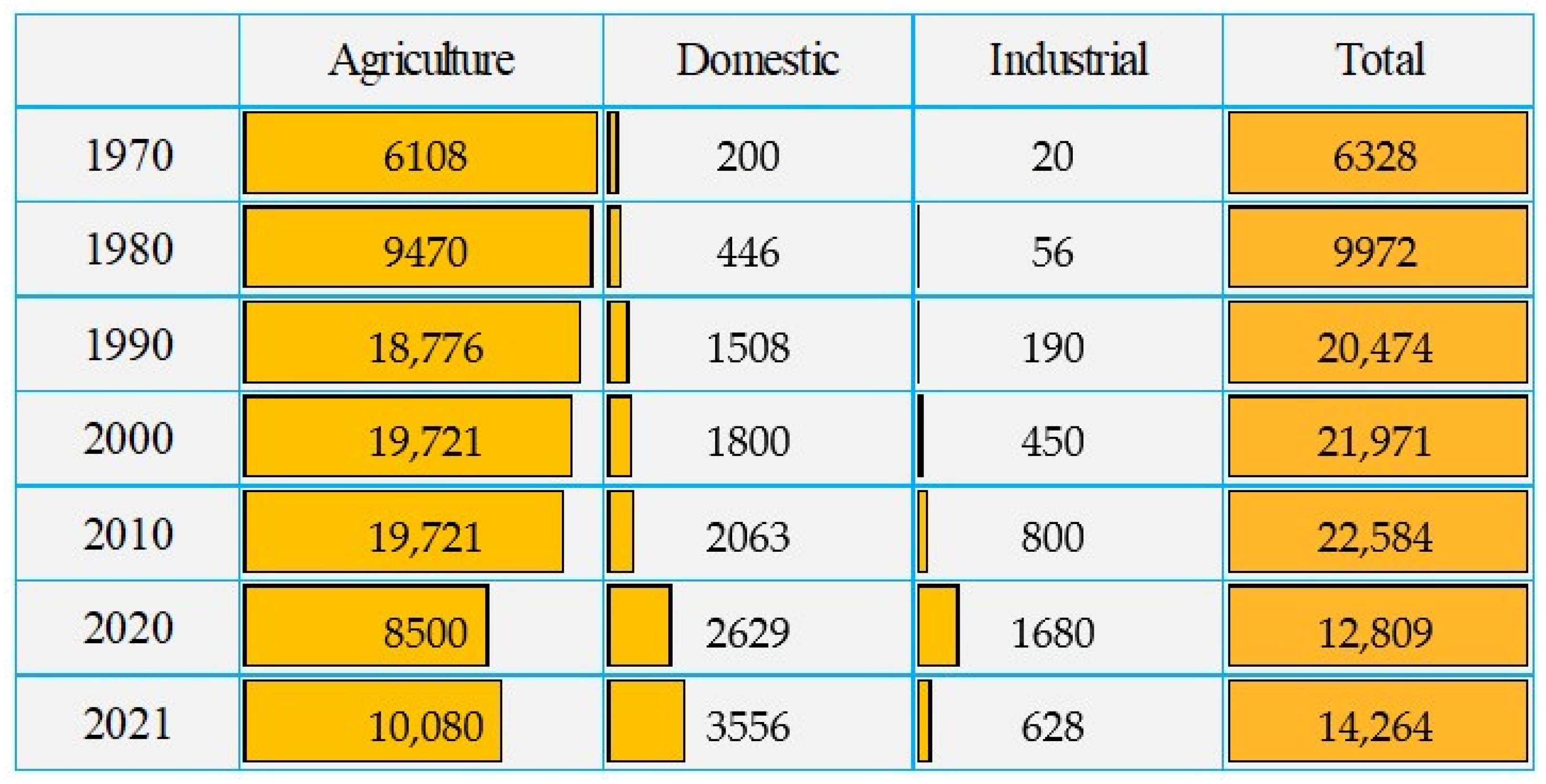
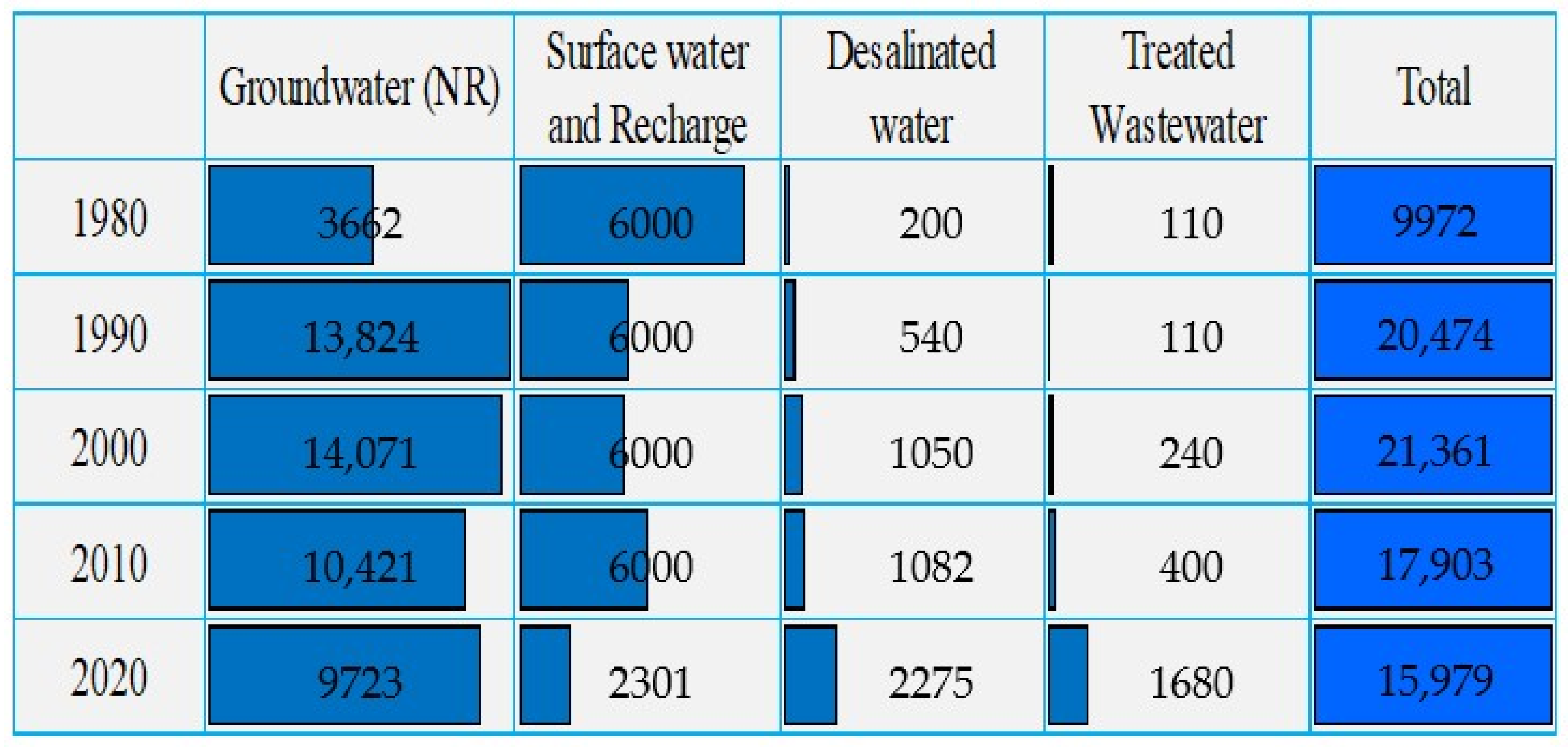
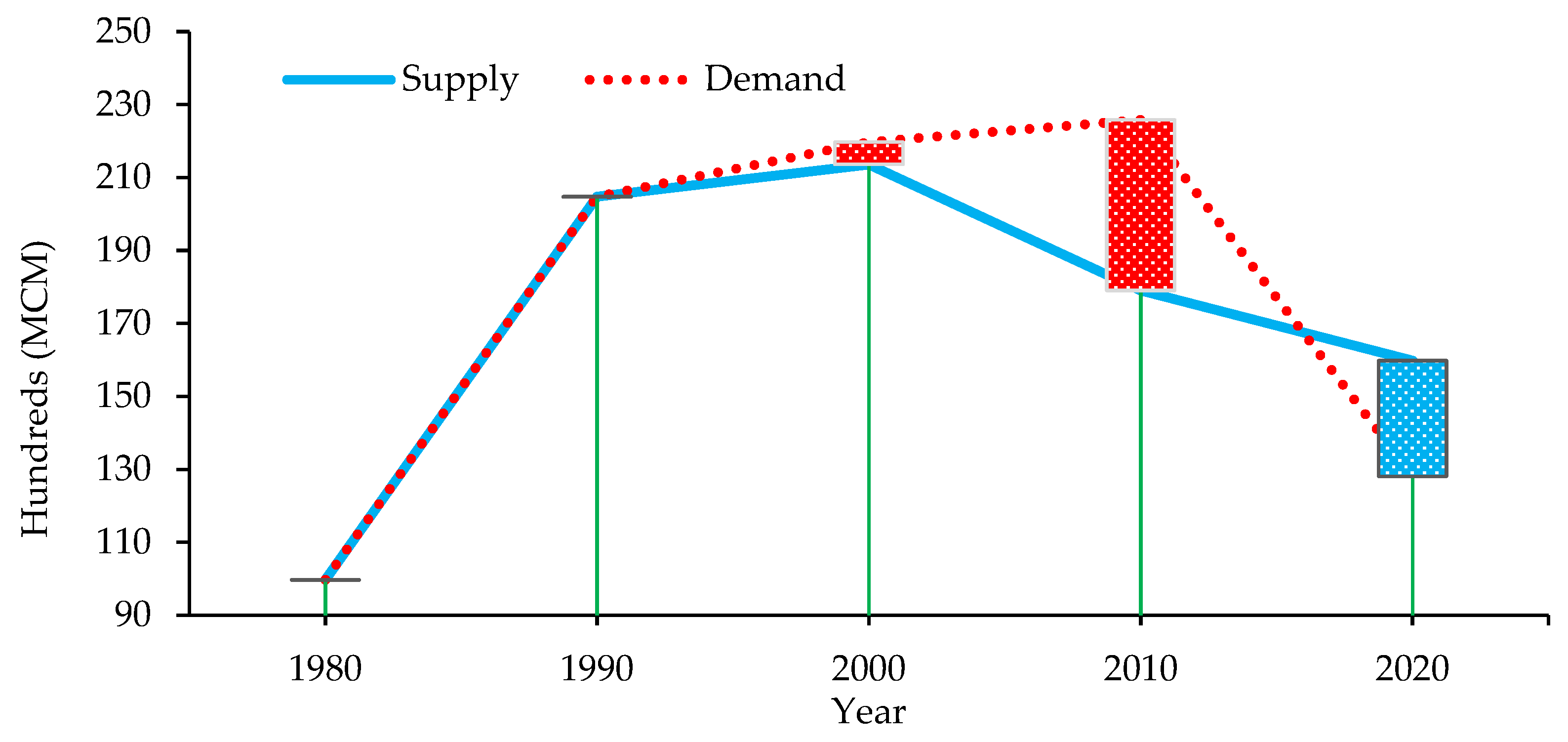
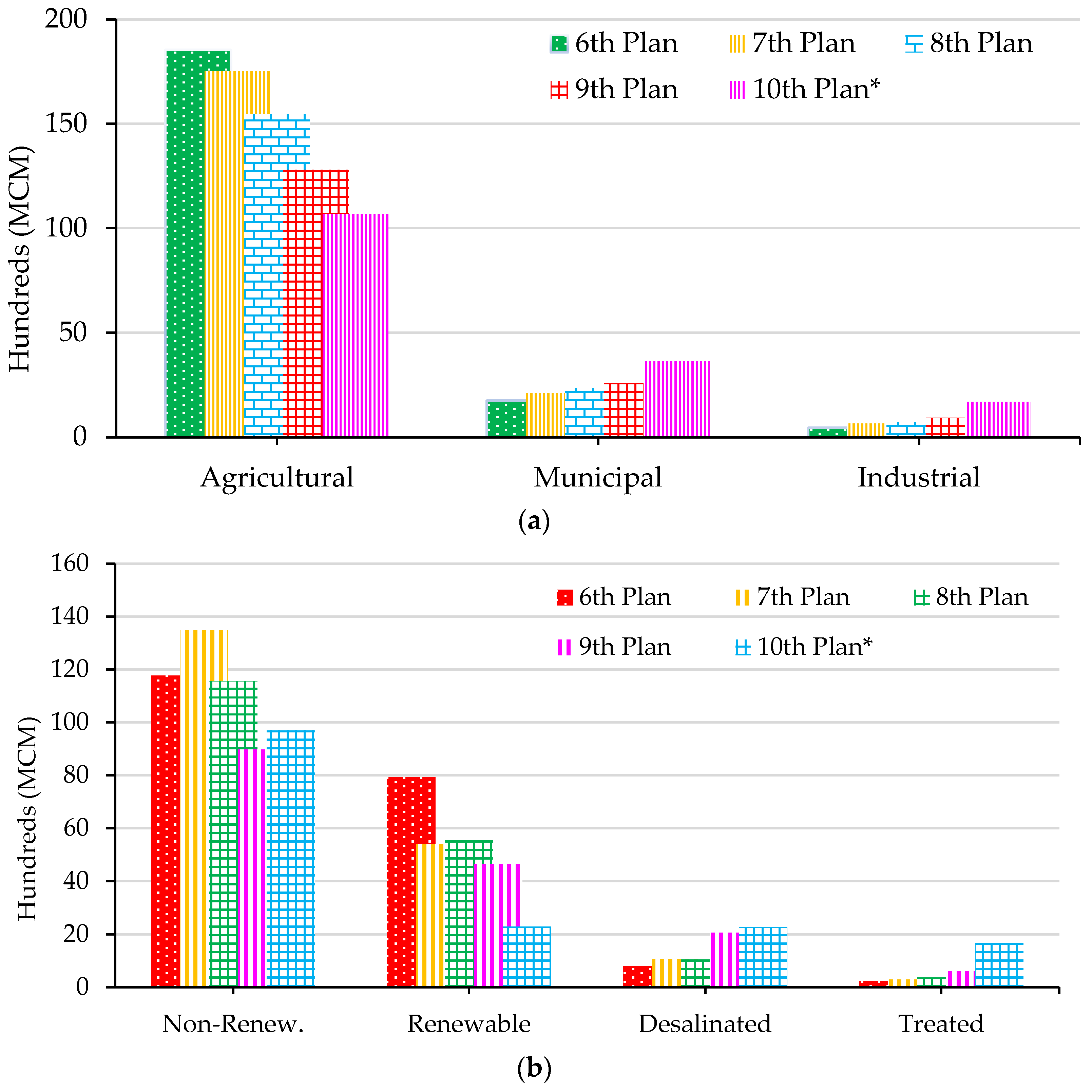
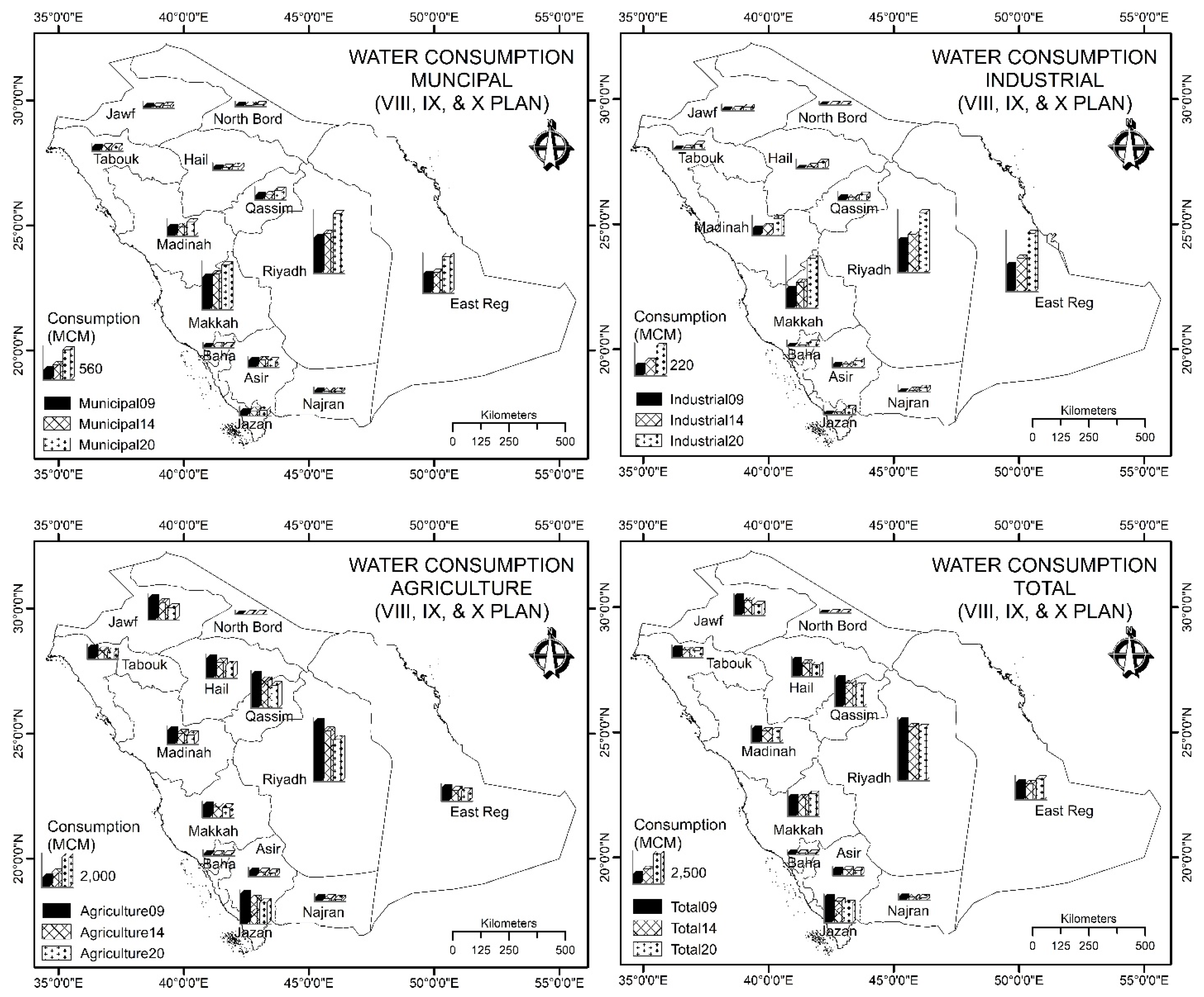

| Sector/Five-Years Plan | 6th Plan (1995–1999) | 7th Plan (2000–2004) | 8th Plan (2005–2009) | 9th Plan (2010–2014) | 10th Plan (2020) * | |||||
|---|---|---|---|---|---|---|---|---|---|---|
| 1999 | % Share | 2004 | % Share | 2009 | % Share | 2014 | % Share | 2020 | % Share | |
| Municipal | 1750 | 8.44 | 2100 | 10.36 | 2330 | 12.59 | 2583 | 15.84 | 3629 | 22.7% |
| Industrial | 450 | 2.17 | 640 | 3.16 | 713 | 3.85 | 930 | 5.70 | 1680 | 10.5% |
| Agricultural | 18,540 | 89.39 | 17,530 | 86.48 | 15,464 | 83.56 | 12,794 | 78.46 | 10,670 | 66.8% |
| Total | 20,740 | 100.00 | 20,270 | 100.00 | 18,507 | 100.00 | 16,307 | 100.00 | 15,979 | 100.00 |
| Non-Renew. | 11,769 | 56.75 | 13,490 | 66.55 | 11,551 | 62.41 | 8976 | 55.04 | 9723 | 60.8% |
| Renewable | 7941 | 38.29 | 5410 | 26.69 | 5541 | 29.94 | 4644 | 28.48 | 2301 | 14.4% |
| Desalinated | 790 | 3.81 | 1070 | 5.28 | 1048 | 5.66 | 2070 | 12.69 | 2275 | 14.2% |
| Treated | 240 | 1.16 | 300 | 1.48 | 367 | 1.98 | 617 | 3.78 | 1680 | 10.5% |
| Total | 20,740 | 100.00 | 20,270 | 100.00 | 18,507 | 100.00 | 16,307 | 100.00 | 15,979 | 100.00 |
| Province | 8th Plan (2005–2009) | 9th Plan (2009–2014) | 10th Plan (2014–2019) * | Average Annual Growth Rate | ||||||||||||
|---|---|---|---|---|---|---|---|---|---|---|---|---|---|---|---|---|
| Municipal | Agriculture | Industrial | Total | Municipal | Agriculture | Industrial | Total | Municipal | Agriculture | Industrial | Total | Municipal | Agriculture | Industrial | Total | |
| Riyadh | 673 | 4089 | 236 | 4998 | 752 | 3467 | 280 | 4499 | 1121 | 2896 | 441 | 4458 | 5.2% | −3.4% | 6.5% | −1.1% |
| Makkah | 608 | 861 | 144 | 1613 | 667 | 737 | 193 | 1597 | 841 | 691 | 368 | 1900 | 3.3% | −2.2% | 9.8% | 1.7% |
| Madinah | 158 | 968 | 52 | 1178 | 178 | 775 | 69 | 1022 | 261 | 646 | 128 | 1035 | 5.1% | −4.0% | 9.4% | −1.3% |
| Qassim | 86 | 2274 | 21 | 2381 | 96 | 1866 | 24 | 1986 | 180 | 1546 | 41 | 1767 | 7.7% | −3.8% | 6.9% | −2.9% |
| East Reg | 353 | 911 | 198 | 1462 | 387 | 734 | 249 | 1370 | 686 | 657 | 431 | 1774 | 6.9% | −3.2% | 8.1% | 2.0% |
| Asir | 124 | 350 | 16 | 490 | 137 | 330 | 24 | 491 | 117 | 272 | 49 | 438 | −0.6% | −2.5% | 11.8% | −1.1% |
| Tabouk | 67 | 733 | 8 | 808 | 75 | 565 | 15 | 655 | 74 | 503 | 42 | 619 | 1.0% | −3.7% | 18.0% | −2.6% |
| Hail | 45 | 1352 | 7 | 1404 | 50 | 1099 | 18 | 1167 | 70 | 896 | 49 | 1015 | 4.5% | −4.0% | 21.5% | −3.2% |
| North Bord | 24 | 4 | 3 | 31 | 27 | 6 | 3 | 36 | 38 | 8 | 4 | 50 | 4.7% | 7.2% | 2.9% | 4.9% |
| Jazan | 86 | 2040 | 8 | 2134 | 97 | 1712 | 20 | 1829 | 112 | 1486 | 47 | 1645 | 2.7% | −3.1% | 19.4% | −2.6% |
| Najran | 37 | 252 | 5 | 294 | 42 | 207 | 12 | 261 | 40 | 152 | 28 | 220 | 0.8% | −4.9% | 18.8% | −2.9% |
| Baha | 30 | 120 | 5 | 155 | 32 | 100 | 11 | 143 | 33 | 76 | 27 | 136 | 1.0% | −4.5% | 18.4% | −1.3% |
| Jawf | 39 | 1510 | 10 | 1559 | 43 | 1196 | 12 | 1251 | 57 | 841 | 25 | 923 | 3.9% | −5.7% | 9.6% | −5.1% |
| Total | 2330 | 15,464 | 713 | 18,507 | 2583 | 12,794 | 930 | 16,307 | 3629 | 10,670 | 1628 | 15,979 | 4.5% | −3.6% | 8.6% | −1.5% |
| Sectors/Scenarios | Rate of Change as per Scenario Analysis | |||
|---|---|---|---|---|
| Actual (SC-I) * | Predicted (SC-II) ** | Predicted (SC-III) ** | Predictor Value | |
| Municipal | 2.1 | 1.6 | 2.6 | ±0.5 |
| Industrial | 5.5 | 4.5 | 6.5 | ±1 |
| Agricultural | −3.7 | −4.2 | −3.2 | ±0.5 |
| Total | −2.5 | −3 | −2 | ±0.5 |
Disclaimer/Publisher’s Note: The statements, opinions and data contained in all publications are solely those of the individual author(s) and contributor(s) and not of MDPI and/or the editor(s). MDPI and/or the editor(s) disclaim responsibility for any injury to people or property resulting from any ideas, methods, instructions or products referred to in the content. |
© 2024 by the authors. Licensee MDPI, Basel, Switzerland. This article is an open access article distributed under the terms and conditions of the Creative Commons Attribution (CC BY) license (https://creativecommons.org/licenses/by/4.0/).
Share and Cite
Suhail, M.; Faraj, T.K.; Ahmad, W.; Ravshanov, A.X.; Khan, M.N. Issues of Water Resources in Saudi Arabia: Past, Present, and Future. Sustainability 2024, 16, 4189. https://doi.org/10.3390/su16104189
Suhail M, Faraj TK, Ahmad W, Ravshanov AX, Khan MN. Issues of Water Resources in Saudi Arabia: Past, Present, and Future. Sustainability. 2024; 16(10):4189. https://doi.org/10.3390/su16104189
Chicago/Turabian StyleSuhail, Mohammad, Turki Kh. Faraj, Waseem Ahmad, Alikul Xudayberdiyevich Ravshanov, and Mohd Nazish Khan. 2024. "Issues of Water Resources in Saudi Arabia: Past, Present, and Future" Sustainability 16, no. 10: 4189. https://doi.org/10.3390/su16104189
APA StyleSuhail, M., Faraj, T. K., Ahmad, W., Ravshanov, A. X., & Khan, M. N. (2024). Issues of Water Resources in Saudi Arabia: Past, Present, and Future. Sustainability, 16(10), 4189. https://doi.org/10.3390/su16104189







